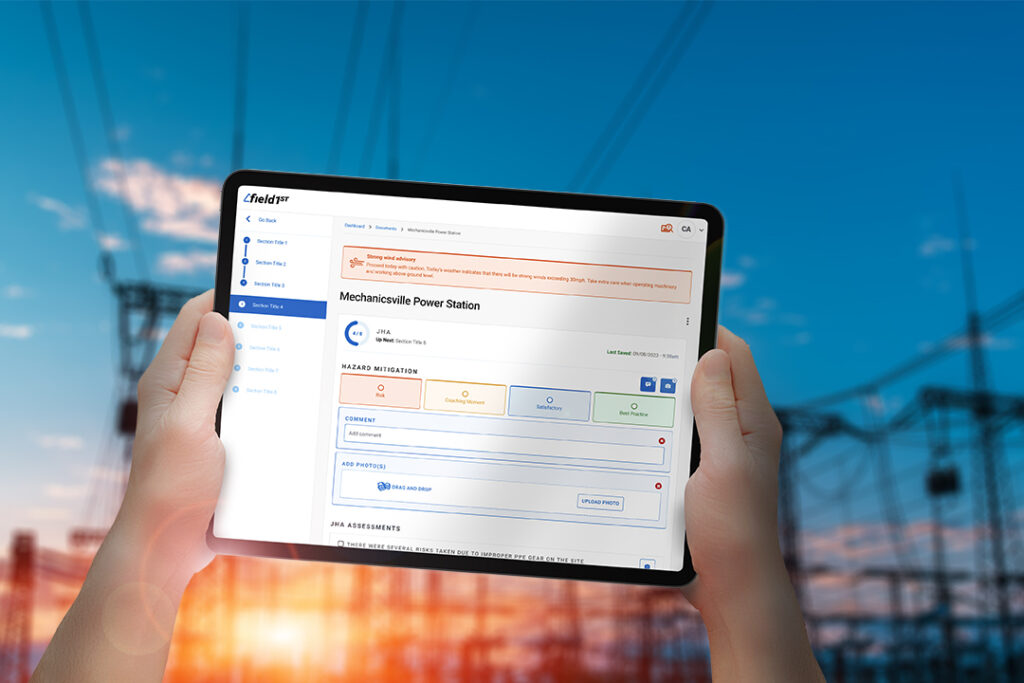In high-risk industries like construction, utilities, and infrastructure, health and safety aren’t optional checkboxes—they’re life-or-death imperatives. One misstep, one missed hazard, one buried compliance gap can ripple across an entire operation: serious injuries, lawsuits, OSHA citations, even project shutdowns.
Health and safety audits are critical tools to prevent that spiral. They help organizations uncover risks early, ensure compliance with OSHA, ISO 45001, and other regulations, and create a repeatable structure for continuous improvement. But here’s the problem: too many companies are still stuck using outdated, manual methods. Paper checklists. Scattered spreadsheets. Delayed reporting. Field teams out of sync with compliance.
Sound familiar?
This guide is built for safety managers, compliance officers, and EHS leaders who want to audit smarter—not harder. You’ll get a step-by-step breakdown of the entire audit process, learn how to spot compliance gaps before they turn into penalties, and discover how modern platforms like Field1st digitize and streamline the entire workflow—without the friction.
Let’s get into it.
What is a Health and Safety Audit?
A health and safety audit is a structured, systematic evaluation of an organization’s safety management practices, policies, and procedures. Unlike basic safety inspections (which focus on immediate hazards), audits dig deeper: uncovering systemic risks, reviewing training effectiveness, validating compliance, and evaluating overall safety performance.
Audits may cover everything from PPE usage and emergency drills to lockout/tagout procedures, contractor safety programs, confined space protocols, and more.
Key Goals of Health and Safety Audits:
- Identify existing and potential workplace hazards
- Verify compliance with OSHA, ISO 45001, and other regulations
- Evaluate safety policies, procedures, and training effectiveness
- Promote accountability and continuous improvement across all teams
How Audits Differ from Inspections: While inspections are usually task-focused and frequent (e.g., daily site walkarounds), audits are more comprehensive and periodic. Inspections say, “Is this hazard present now?” Audits ask, “Why do hazards keep recurring—and what does that say about our systems?”
Audits help an organization mature its safety programs from reactive to preventive—and ultimately, predictive. That evolution is the backbone of effective safety leadership.
Additionally, safety audits serve as an essential tool for internal benchmarking. Over time, they help compare different project sites, crews, or divisions—enabling leaders to pinpoint underperforming areas and replicate top performers.
Why Health and Safety Audits Matter
Ensuring Compliance with OSHA, ISO 45001 & More
Regulatory agencies like OSHA and ISO mandate safety procedures and documentation. A lapse can cost companies tens of thousands in fines—or worse. OSHA’s electronic recordkeeping rule now demands even more transparency: businesses must submit detailed injury/illness records annually. Audits ensure you’re not caught off guard.
Routine audits help identify gaps before regulators do. If your site is subject to surprise inspections or part of a public contract, your audit trail could be the difference between passing and penalties.
Staying compliant also improves reputation. Clients, insurers, and partners want to work with organizations that prioritize safety. Audits demonstrate that commitment in black and white.
And with international workforces and contractors, alignment on standards like ISO 45001 makes collaboration smoother and safer across borders.
Preventing Accidents and Saving Lives
From electrocutions to falls, most serious workplace injuries are preventable. But only if you find the risks before they become incidents. A thorough audit spots cracks in the system: missing equipment checks, training lapses, overlooked near-misses.
Consider this: in construction, 40% of worker deaths stem from falls. And yet fall protection violations remain OSHA’s most cited issue. That gap? It’s auditable.
Every incident avoided is a life protected—and often, a job saved. Audits reduce reactive firefighting by creating an environment where problems are anticipated and neutralized early.
For example, in a real-world scenario, a contractor’s safety audit discovered repeated violations in scaffolding assembly protocols. Through targeted retraining and the introduction of a digital inspection checklist, the team reduced related near-misses by 70% within six months.
Building a Culture of Safety
Audits create accountability. When safety is measured, it matters. Conducting regular audits signals to employees and leadership that safety is a core business value—not a box to check. It also empowers employees to voice concerns, knowing their input drives real change.
The act of auditing itself shifts attitudes. When workers see that safety practices are monitored, enforced, and improved over time, participation increases. They stop seeing PPE as a burden—and start seeing it as a tool of protection.
A culture of safety isn’t just a feel-good initiative—it’s a competitive advantage. Teams that feel safe and supported perform better, collaborate more effectively, and take ownership of outcomes.
Cost Avoidance & Operational Efficiency
Each lost-time injury costs construction firms an average of $35,000 in direct expenses—and much more in indirect costs like downtime, rework, or legal fees. One audit can identify a risk that saves you six figures. It’s not just about compliance—it’s ROI.
It’s also about momentum. Audits uncover small inefficiencies—confusing signage, unclear workflows, outdated training—that, when fixed, accelerate project delivery and reduce administrative drag.
The knock-on effect? Lower insurance premiums. Improved bid competitiveness. Fewer delays. A smoother workflow across the board.
Types of Health and Safety Audits
Different audits serve different purposes. Here’s a breakdown of the main types:
1. Compliance Audits
Ensure you meet regulatory standards (OSHA, ISO 45001, state-specific rules). These audits check if required documentation, signage, procedures, and equipment are in place.
They often follow a checklist approach, comparing your current practices against legal requirements. Failure in a compliance audit can lead to regulatory penalties or increased insurance premiums.
2. Program Audits
Evaluate internal safety policies and training programs: Are workers trained? Is PPE use enforced? Are incident investigations thorough and timely?
Program audits ensure that what’s on paper actually translates into real-world action. They reveal gaps between intent and execution.
3. Management System Audits
These go deeper into Safety Management Systems (SMS), assessing leadership commitment, employee involvement, objectives, and continual improvement processes.
Think of this as an audit of your safety culture’s architecture. Do leaders walk the talk? Is safety integrated into planning, procurement, hiring?
4. Behavioral Audits
Observe real-world behaviors: Are workers following protocols? Do they understand the “why” behind them? These audits assess the strength of your safety culture.
It’s about the human element—catching unsafe behaviors before they cause incidents. These are typically conducted informally and repeatedly to track trends.
5. Thematic Audits
Target specific issues like hazardous material handling, confined space entry, hot work protocols, or ladder safety.
They’re useful after a near-miss, a policy change, or ahead of a specialized operation. Narrow focus = high precision.
6. Site Audits
On-the-ground inspections of worksites to check signage, housekeeping, fall protection, emergency exits, machine guards, and more.
These are the most visible form of audits and often form the backbone of a company’s safety compliance efforts. Field1st allows safety managers to schedule, execute, and track these efficiently across multiple locations.
5 Key Steps in Conducting a Health and Safety Audit
A safety audit isn’t just about checking boxes—it’s your early warning system. Done right, it exposes blind spots, flags future risks, and turns compliance into culture. Here’s how to run one that actually moves the needle:
Step 1: Plan and Prepare
Before boots hit the ground, set the strategy:
- Define the audit’s scope and objective. Are you focusing on fall protection on one jobsite—or evaluating your entire program against OSHA 1926 or ISO 45001?
- Align with applicable regulatory standards. Your audit should mirror the frameworks that govern your work.
- Select auditors carefully. Use internal EHS teams or bring in third-party experts for an unbiased view.
- Gather all relevant documentation. This includes prior audit reports, incident logs, inspection records, and training documentation.
Why it matters: A solid prep phase ensures clarity across teams, avoids duplicate work, and sets the tone for collaboration—not confrontation.
Pro Tip: Bring in frontline supervisors early. They’ll help surface day-to-day friction points that audits often miss—and they’ll own the fixes faster when they’ve been part of the process.
Step 2: Identify Safety Risks and Compliance Gaps (add featured Image)
This is the investigative heart of your audit.
- Conduct site walkthroughs. Observe operations in real time—not just in the breakroom or conference room.
- Interview employees and supervisors. Ask what’s working and what isn’t—especially around recent incidents or process changes.
- Analyze data. Review near-miss logs, safety observations, and recent injuries.
- Leverage Field1st. Use mobile tools to flag hazards instantly, capture photos, and log behaviors without paper bottlenecks.
Why it matters: Audits often uncover issues that aren’t in the incident log yet. Leading indicators—like blocked exits or missing signage—are early warnings. Field1st helps you catch them on the spot and start the fix while you’re still on-site.
Optional Add-On: Deploy anonymous surveys during this phase. Field crews usually know what’s broken—but won’t always say it out loud unless they feel safe.
Step 3: Document Findings
No data? No improvement.
- Use structured formats—checklists, annotated photos, and timestamped notes.
- Categorize findings by risk level. Immediate hazards go to the top. Routine items still get logged but tracked with longer timelines.
- Digitize everything. Field1st auto-organizes your findings, making sure nothing slips through the cracks.
Why it matters: Too many audits die in this phase. Disorganized notes, inconsistent language, or handwritten forms prevent follow-through.
Bonus Tip: Document what’s working too. Reinforcing good behaviors boosts morale and helps you replicate success across sites.
 Step 4: Implement Corrective Actions
Step 4: Implement Corrective Actions
This is where paper turns into action—or doesn’t.
- Assign clear owners. Every finding needs a name next to it.
- Set deadlines and monitor progress. Safety issues shouldn’t sit unresolved for weeks.
- Track status in real time. With Field1st, unresolved hazards automatically escalate to the next level of supervision—so accountability never drops off.
Example:
Audit reveals missing guardrails on mezzanine → Supervisor notified → Rails installed in 24 hours → Re-audited and closed out in Field1st with photos and timestamp.
Why it matters: An audit without action is just admin work. Corrections should be fast, traceable, and built into workflows.
Extra Credit: Use audit findings in toolbox talks or team briefings. When safety is used to teach—not just punish—you get real culture change.
Step 5: Continuous Monitoring and Improvement
Schedule follow-up audits or spot checks
Safety isn’t static—and neither is your audit process.
- Schedule regular follow-ups. Quarterly spot checks and unannounced audits keep teams alert.
- Track KPIs like:
- TRIR (Total Recordable Incident Rate)
- Open audit item count
- Near-miss reporting trends
- Time to corrective action closure
- TRIR (Total Recordable Incident Rate)
- Use analytics to go proactive. With Field1st dashboards, spot recurring risks and tweak your programs before issues repeat.
Why it matters: Top-tier safety teams don’t “audit annually.” They build safety monitoring into the rhythm of operations—so audits become a habit, not an event.
Challenges in Safety Audits (And How to Beat Them)
Even the most well-meaning safety programs hit roadblocks. Whether it’s outdated tools, incomplete data, or internal resistance, here’s how to beat the most common audit challenges—before they snowball into risk.
P Manual Audits Are Time-Consuming & Prone to Errors
Paper-based audits are slow, inconsistent, and vulnerable to human error. Forms get lost. Spreadsheets break. And even small mistakes can cost time, money, and credibility.
Solution: Field1st automates your audit workflows. With mobile-friendly digital checklists, real-time data capture, and offline functionality, teams can log issues on-site–instantly and accurately. No more paperwork. No more lag time.
Difficulty in Tracking & Managing Safety Compliance Across Sites
Trying to manage safety across multiple job sites with disconnected tools is like driving blindfolded. Without centralized visibility, it’s nearly impossible to know what’s overdue, what’s noncompliant, or what’s at risk.
Solution: Field1st provides real-time compliance dashboards that track open items, overdue actions, and completion rates across every location. Automated alerts and audit scheduling make sure nothing slips through the cracks—ever.
C Lack of Standardized Safety Data & Reporting

When every supervisor tracks audits differently—or worse, not at all—you end up with messy, inconsistent data that can’t be analyzed or acted on.
Solution: Field1st enforces consistent reporting standards with customizable templates, required fields, and built-in data structure. That means every audit speaks the same language—making it easy to spot patterns, measure progress, and make smart decisions.
Inconsistent Reporting
Different supervisors report differently. Some skip steps. Some just forget.
Solution: With Field1st’s customizable checklists and required fields, everyone follows the same process every time.
H Identifying Hidden Hazards

Not all risks are visible during a walkthrough. Air quality, fatigue, ergonomic strain, and other “invisible” hazards often go undetected until someone gets hurt.
Solution: Field1st helps detect what your eyes can’t see. It integrates with IoT sensors, wearables, and environmental monitors to alert safety teams to VOCs, heat exposure, and more—turning data into action before risks escalate.
Resistance to Change from Employees & Management
Let’s face it—most crews view audits as a hassle. And if leadership doesn’t back the process, it loses power fast. Without buy-in, audits become a box-checking exercise instead of a catalyst for change.
Solution: Bring the team in early. Use audit results to highlight wins—not just faults. Field1st makes safety visible with shared dashboards and performance metrics, so everyone—from foreman to field crew—can see the impact of their actions.
Pro tip: Celebrate the fixes. When safety improvements are shared company-wide, adoption goes up—and resistance drops fast.
Streamline Your Health and Safety Audits with Field1st

If you’re relying on clipboards, spreadsheets, or siloed systems to manage your safety audits–you’re flying blind.
Field1st bring structure, speed, and intelligence to every part of the audit process, so nothing gets missed, delayed, or buried under paperwork.
Here’s how it changes the game:
- Mobile-First Audit Tools
Complete inspections directly from the field—phone or tablet. No signal? No problem. Field1st works offline and syncs when back online.
- Real-Time Alerts & Auto-Escalation
Critical issues trigger instant notifications and follow-up tasks, keeping high-risk findings from falling through the cracks.
- Centralized Compliance Tracking
All your safety data—audits, corrective actions, checklists, and scores—in one place. Perfect for single sites or multi-location oversight.
- Smart Dashboards & Predictive Analytics
Visualize audit performance across time, teams, and regions. Spot trends. Act on patterns. Get ahead of risk.
- Auto-Generated Regulatory Reports
Instantly produce OSHA 300 logs, ISO documentation, or site-specific audit records—ready for inspectors or internal reviews.
- Supports ISO 45001 Out-of-the-Box
Field1st aligns with ISO’s core clauses for risk management, corrective action, employee involvement, and performance evaluation.
Whether you’re overseeing one site or fifty, Field1st turns every audit into an opportunity for action—not just a box to check. From site supervisors to regional EHS leaders, everyone gets visibility, accountability, and control.
No more missed hazards. No more audit gaps. Just a faster, smarter path to safer operations.
Final Word
A health and safety audit isn’t just a checklist. It’s your frontline defense against risk, injury, and liability. It’s how you build a safety culture that actually works—from boardroom to backhoe.
And with modern tools like Field1st, you don’t just audit faster. You audit smarter. With better data. Fewer incidents. Clearer compliance. And a team that’s aligned, not overloaded.
If you’re ready to eliminate the guesswork and get proactive about workplace safety:
Explore Field1st’s safety audit platform now.
Your crews deserve better. Your compliance demands it. Let’s make audits your competitive advantage—not your headache.




